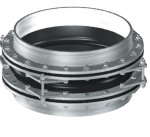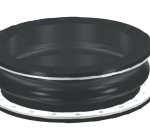Rubber Expansion Joints: A Simple and Efficient Solution for Vibration Damping
Rubber expansion joints are a type of flexible connector and are considered one of the simplest forms of expansion joints. These joints are primarily used to absorb vibrations caused by the operation of equipment such as pumps, compressors, fans, etc.
Advantages of Using Rubber Expansion Joints
- Simplicity: These joints are among the simplest expansion joints and are easy to install and maintain.
- Efficiency: Rubber expansion joints are highly effective in absorbing vibrations and oscillations.
- Corrosion Resistance: These joints are resistant to chemicals and corrosive substances.
- Wear Resistance: Rubber expansion joints have high resistance to wear.
- Affordable Price: These joints are available at a reasonable price.
Applications of Rubber Expansion Joints
- Oil and Gas Industries: These joints are used in refineries, petrochemical plants, and oil and gas pipelines to absorb vibrations from pumps, compressors, and other equipment.
- Power Plants: Rubber expansion joints are used in power plants to absorb vibrations from pumps, compressors, and turbines.
- Chemical Industries: These joints are used in chemical industries to absorb vibrations from pumps, compressors, and other equipment carrying corrosive chemicals.
- Food and Pharmaceutical Industries: Rubber expansion joints are used in the food and pharmaceutical industries to absorb vibrations from pumps, compressors, and other equipment in production lines.
Types of Rubber Expansion Joints
Rubber expansion joints are classified into two main categories based on their curing process:
- Bladder Rubber Expansion Joints: These joints are cured using molds under steam pressure.
- Autoclave Rubber Expansion Joints: These joints are cured in an autoclave under high pressure and temperature.
Considerations for Selecting and Using Rubber Expansion Joints
- Type of Fluid Passing Through: The type of fluid, its chemical composition, and its corrosiveness should be considered when selecting the joint type.
- Temperature of the Fluid: The temperature of the fluid should be taken into account. Rubber expansion joints can withstand temperatures up to 140 degrees Celsius.
- Pressure of the Fluid: The pressure of the fluid should be considered. Rubber expansion joints can withstand pressures up to 25 bar.
- Amount of Vibration and Oscillation: The amount of vibration and oscillation should be considered when selecting the joint type.
- Weather and Environmental Conditions at the Installation Site: The weather and environmental conditions of the installation site should be considered when choosing the joint.
- Installation: Rubber expansion joints should be installed by experienced professionals.
- Inspection and Maintenance: Rubber expansion joints should be periodically inspected and repaired or replaced if necessary.
Klevers Aryana Company, with extensive experience in the production and supply of rubber expansion joints, offers ideal solutions tailored to your needs.
For more information and to receive a free consultation, contact the experts at Klevers Aryana.





